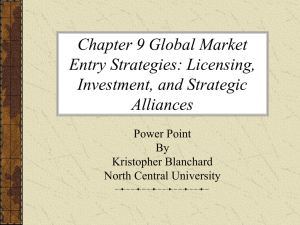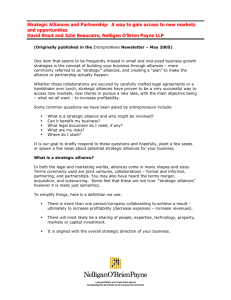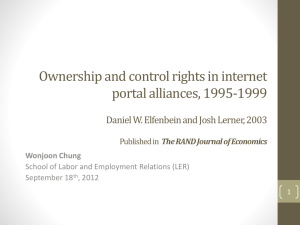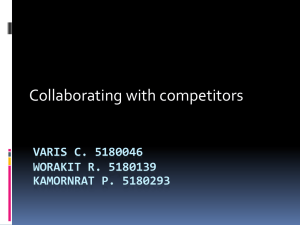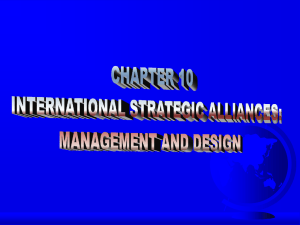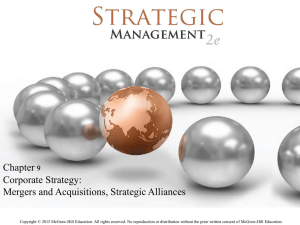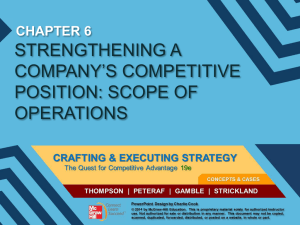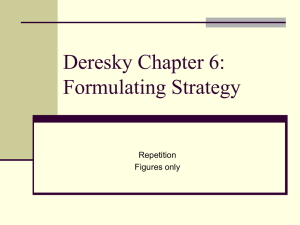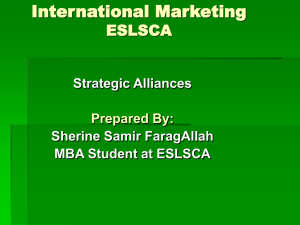Strategic alliances and their cultural aspects - Pc
advertisement
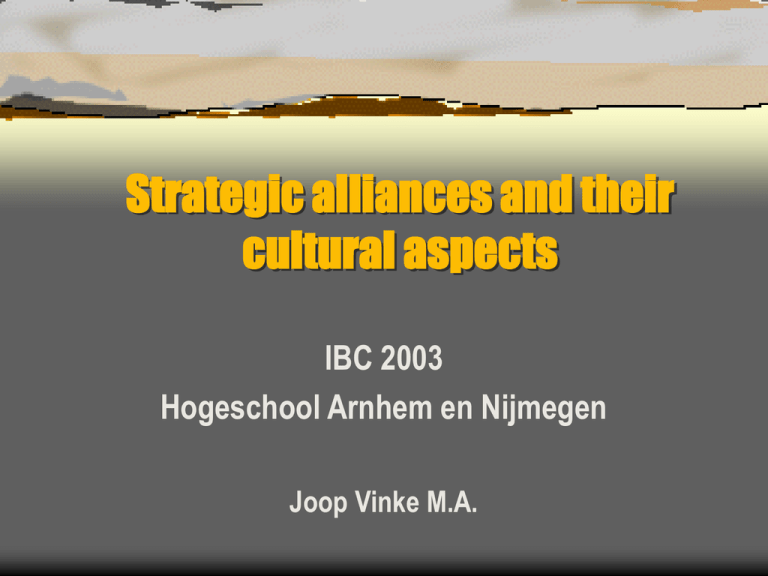
Strategic alliances and their cultural aspects IBC 2003 Hogeschool Arnhem en Nijmegen Joop Vinke M.A. Definition of an alliance Arm’s length control 1. 2. 3. Alliance Merger or Acquisition Open-ended (“incomplete”) agreement Between separate firms With shared control important motives for entering into strategic alliances 1. 2. 3. 4. 5. 6. 7. 8. Obtaining know-how Entry to (new) markets Increasing efficiency Spreading business risks Offering integrated solutions to clients Increased competition due to liberalisation of markets Growing costs and necessity to bring new products and services to the market Trend to follow the leader Mergers, Acquisitions and Takeovers Merger: any transaction that forms one economic unit from two or more previous units Acquisition: the purchase of a controlling interest in a firm, generally via a tender offer for the target shares Takeover: a general term which includes both mergers and acquisitions Kinds of alliances - Tactical and strategic alliances; (Van Gils, 2000) - Horizontal, vertical (upstream/downstream), diversification, and diagonal alliances; (Macbeth & Ferguson, 1994; Nooteboom, 1999) - Strategic alliances: learning, business, and hybrid alliances; (Koza and Lewin, 2000) - Scale alliances (horizontal, business) and complementary alliances (learning). (Garrette and Dussage, 2000) Advantages of co-operation - - - forming novel combinations of perspectives stimulates specialization (and through that economies of scale) sharing of risks motivation for survival and continuity (of smaller firms) more flexibility and greater diversity of sources of competence Polygamy is O.K.!!! A single ideal partner seldom exists Complexity demands multiple capabilities But: Promiscuity is not………. From traditional competition To group vs. group Results: From ……………… To……………. Traditionally rivalry Firm vs. Firm Firms advantage Core competence Corporate structure Collective competition Group vs. Group Group advantage Group competence Group structure How to build strategic alliances? Strategic alliances are formed to unite culturally different partners in pursuit of a common objective. Successful alliance leaders manage the relationship in the context of the partner’s cultural differences, finding ways to create value from complimentary differences and reduce the impact of those differences that impede alliance success But remember: The number of successful alliances is still less then 50% The influence of alliances on the culture of organisations Results of a survey of 455 CEO’s in 2000: 1. 2. 3. 4. 5. 6. 7. 8. Overly optimistic Poor communication Lack of shared benefit Slow results for payback Lack of financial commitment Misunderstood operating principles Cultural mismatch Lack of alliance experience Spekman, Robert E., Alliance competence, New York 2000 What is CULTURE? Symbols: gestures, words, objects etc. of which only the group members know the meaning Heroes: public figures, dead or alive, real or fictive, who serve as role models Rituals: acts that, for outsiders, may seem useless but are socially essential Norms and Values Norm: What is right? / What is wrong? Value: What is good / bad? What is beautiful / ugly? What is natural / artificial? What is normal, not normal? Etc. Explicit culture Symbols Heroes Rituals Values and Norms Is culture inborn or learned? Definitions: “The right way of doing things”” “The collective mental programming of people in an environment “The collective preference of one decision above another one”” “Integrated system of patterns of behaviour which are acquired by all members of a society Models: 1. Hofstede PDI - power distance the extent to which a culture accepts that power in organizations is distributed unequally MAS - Masculinity the value attributed to achievement, assertiveness, and material success as opposed to the stereotypical feminine values of relationships, modesty, caring and the quality of life. IDV - Individualism the extent to which people are supposed to take care of themselves and be emotionally independent UAI - Uncertainty avoidance the degree to which members of a society are uncomfortable with risk and uncertainty CDI - Confucian dynamism the extend to which a society exhibits a pragmatic future-oriented perspective rather then a conventional historic or short time point of view Models: 2. Trompenaar The seven dimensions of culture universalism vs. particularism individualism vs. collectivism neutral vs. affective relationships specific vs. diffuse relationships achievement vs. ascription Sequential vs. synchronic culture Internal vs. external control Universalism vs. particularism What is more important - rules or relationships? Universalism: “What is good and right can be defined and always applies!“ Particularism: Great attention to the obligations of relationships and unique circumstances Individualism vs. collectivism Do we function in a group or as an individual? A. B. “It is more important to focus on individuals so that they can contribute to the collective as and if they wish” “It is more important to consider the collective first since that is shared by many individuals” Neutral vs. affective (emotional) relationships “The nature of our interactions should be objective and detached” North European business relationships “The expressing the emotions is part of the relationship and therefore acceptable” South European business relationships Specific vs. diffuse relationships When the whole person is involved in a business relationship there is a real and personal contact, instead of the specific relationship prescribed by contract. Achievement vs. ascription Do we have to prove ourselves to receive status or is it given to us? Achievement: “One will be judged on what you have recently accomplishes and on your record.” Ascription: “The status is attributed to you, by birth, childhood, gender or age, but also by your connections and your educational record.” Sequential vs. synchronic culture Is time a line ? …..or is it a circle? Past, present and future Past Present Future …. Or? How would You draw it?? Internal vs. External control Do we control our environment or work with it ? 1. 2. Major focus affecting their lives and the origins of vice and virtue as residing within the person (part of the nature) World is more powerful than individuals. Nature is to be feared or emulated. Global Literacy Be effective in doing business and managing with different culture This applies equally to: 1. those working where there is diversity in the work force 2. those travelling and working in different cultures 3. those receiving business visitors from other cultures Don’t………..! Change your behaviours to try to emulate the culture(s) you are working with. or Simply 'Do in Rome as Romans do... etc. Try …………Reconciliation In dealing with different cultures, you have several options: • Ignoring other culture • Abandon your standpoint • Compromise or………… Reconciliation: Universalism …Apply rules and procedures universally to ensure equity and consistency although…… …We do not want to drown in chaos or lose our sense of central directions so we must… Central guidelines with local adaptations and discretion …We do not want to degenerate into rigidity and bureaucracy so we must……… ..Encourage flexibility by adapting to particular situations. However...... Particularism Cultural differences How does a company learn and work, Where is it? Whom does it serve and how?………….. …….are all manifestations of its culture. How does it deliver knowledge throughout the organization? What is the corporate structure? What practices distinguish its operations? Who are its stakeholders? What are their objectives? Company-culture is defined by the answers to these questions, but determined by the context in which the company exists. Three types of cultures affecting organizations and alliance partner behaviour National / Ethnic Culture Industry / Organizational Culture Professional Culture 1. National / Ethnic Culture The values and norms that create the society in which the partner organization is based. Drives for thinking, communications styles, attitude towards hierarchy, gender roles and other aspects of individual and group A model for defining national culture based on the diversity of European regimes Rheinic model Germany, Austria, Netherlands,Scandinavia, France Anglo-Saxon model UK, Ireland Latin Rim model Greece, Spain Southern Italy, Portugal The “Rheinic” model Social partnership in various forms Germany, Austria, Netherlands, Scandinavia, France Juridified industrial relations Work councils Emphasis on social cohesion and social market Welfare as “first resort” Corporatist tradition The “Anglo-Saxon” model Free market UK, Ireland Voluntarist, adversarial industrial relations Free market Welfare as “last resort” The “Latin Rim” model Greece, Spain Southern Italy, Portugal Conflictual, antagonistic industrial relations Mixed labour market Rudimentary welfare (church, family support) 2. Industry / Organizational Culture “Reflects the values and norms that permeate the organization” It is distinguished by: orientation towards risk, collaborative management style, maturity, corporate arrogance, level of centralization market focus, among others. 3. Professional Culture “the values and norms embodied by professionals of a specific discipline” People in different occupations usually incorporate the professional biases associated with their roles within the organization Managing cultural differences Define differences! Research! Simplify! Management! Building alliance competence The most frequently items that companies miss are: An “alliance-culture” throughout the organisation A clear understanding of how and where within the company the alliance issues should be resolved The know-how to develop internal alliance competences Five steps to build alliance competence 1. 2. 3. 4. 5. Embracing the concept Identify alliance responsibility Allocate dedicated resources Adopt a methodology Develop an alliance process Alliance Strategies “More important than creating strategic alliances is to develop alliance strategies” B. Gomez-Casseres (2002) 1. 2. 3. 4. Let Business strategy drive alliance decisions Grow relationships; don’t “do deals” Create portfolios of alliances, not stand alones Organize internally to co-operate externally

